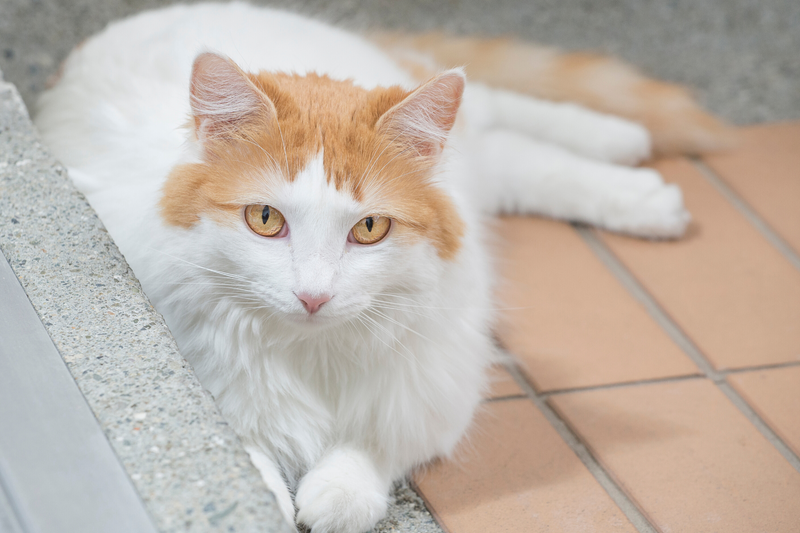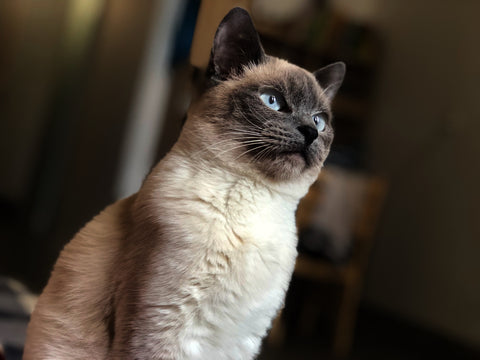
The Turkish Van is a playful and intelligent breed that is ready to take you on an adventure.
With a striking wisp of color topping their head and its tail painted to match, this mostly white cat is one of the rarest in the world. Let us introduce you to the Turkish Van.
The Origin Story
The Turkish Van is a breed with a rich history. They are known as one of the oldest breeds in the world and also one of the rarest! Thought to have emerged organically from southwest Asia near a secluded lake known as ‘Lake Van’ in Turkey.
The Turkish Van is also known as just ‘The Van.’ Formally known as the ‘Turkish Cat’ upon their initial discovery, people often confused the Turkish Van with the Turkish Angora. The term ‘Van’ was added at the end of the name to differentiate the two cat breeds.
The Turkish Van is believed first to be introduced in the story of Noah’s Ark; As Noah began to pair animals two by two upon his arc, a pair of what later would be known as Turkish Vans boarded. During the journey, it is said that the two cats jumped into the water and swam towards the closest shore. Once the rain had diminished, the cats began to walk across the land, eventually making a home in Lake Van.

Though being a newer breed in North America, the Turkish Van has ties back to between 6,000 BC and 3,000 BC. Further confirming the title of the Van being a part of the oldest breeds still populating the world. This is also evident in artifacts depicting cats that surprisingly resemble the Turkish Van. Around the time of the Crusades, people believe that soldiers and explorers helped bring the Vans to Europe upon returning from war.
The Modern history of the Van starts with Sonia Halliday and Laura Lushington, two British photographers sent by the Turkish Tourist Association to photograph Lake Van in 1955. Upon finishing their assignment, the two were gifted two unrelated Turkish Vans with the now infamous ‘Van pattern.’ When the British photographers returned to The United Kingdom, the two cats mated and were used as the base-lineage for Turkish Van cats in England. The Van wasn’t officially introduced to America until 1982.
Today the Turkish Van is being protected by the Turkish College of Agriculture in contact with the Ankara Zoo located in Ankara, Turkey. The Ankara Zoo also breeds and helped save the Van’s cousin, the Turkish Angora, from extinction. The Van breed is no longer authorized to be transported from Turkey. Today most Turkish Vans are bred from Europe and America. According to the CFA(Cat Fanciers’ Association), around 100 Turkish Vans are born in The United States a year, which is why the Van is one of the rarest cat breeds in the world to this day.
Main features of the Turkish van
The Turkish Van is regarded as one of the most beautiful cats in the world, with their predominantly white body and kissed with colored markings on their head and tail. These fur decorations are known as the “Van Pattern.” These patterns are solely confined to the head and tail. For the Turkish Van, these markings can come in many colors and arrangements, including black, blue, and red. Their patterns can be solid, tortoiseshell, or tabby. The most famed design for the Van is known as the ‘Van Gene,’ having a burst of red or brown on their head and tail. You can also find all-white Vans; these are known as “Turkish Vankedis.”

The Van’s body is often compared to a swimmer’s body, as they have large barrel-chests matched with a durable and extended frame. Their tail is lengthy and sturdy, known for its beautiful blossoming fur. They have a stocky neck attached to broad shoulders and can weigh up to 18 pounds (8.16 kg). This is why the Vans are frequently referred to as the ‘jocks’ of the cat world.
The Turkish Van’s head sits square upon their shoulders, topped with a short and round muzzled face. Their ears are a little larger and rounder than most breeds. Their quite large eyes come in either blue or amber but can also come in mismatched colors known as Heterochromia iridium. The ears are feathered, matching their legs and paws. Their strong legs are set far apart and flow into large and rounded feet.
The Van’s coat is soft to the touch and absent of an undercoat. With semi-long hair that is often compared to cashmere. The Turkish Van has two coat lengths depending on the season. The winter coat is longer and thicker than its shorter summer counterpart. The fur around their face is short, but a bloom of fur is packed on the tail.
Personality
Not one for long cuddles, the Turkish Van is all about adventure and action! They want to play and are well known for their dynamic personalities. These cats have strong and deep relationships with their guardians. They insist on having a lot of attention and play. Often if they do not get the amount of acknowledgment they want, they will indeed let you know. Vans are an extremely talkative breed and will talk, sing, and yell at you whenever they see fit.
This breed is also known as the “Swimming Cat,” and this has nothing to do with their swimmer-esque bodies. They do indeed love water, often seeking out any form of liquid they can find. This means Van’s owners must be on high alert when it comes to sinks, toilets, and cups left unattended. They are known to jump in the shower or bath with you as well. Being an intelligent breed, they can learn how to turn on faucets and flush toilets. Dropping toys in the toilet and their water bowls are a fun game they play while waiting for their owners to give them attention. For some Turkish Vans playing with puddles just isn’t enough because Vans love to swim! Whether they are having an adventure in a pool or a stream, swimming is an excellent form of exercise and meets their energetic needs.

Due to the Turkish Van’s activity level, it is not recommended for homes with small children. Like all domestic cats, they stem from the African Wild cat, and Vans seem to have a bit of their hunter heritage still prominent in their attitude. This breed likes to be up high. They enjoy looking upon their environment from atop of shelves and refrigerators. Vans are confident and seem to take the position as the defender of the home. They are known to growl if they are threatened.
Health and Care
Turkish Vans are relatively healthy cats. However, like all cats, there are things to watch out for in order for them to have the best quality of life. The Van breed is susceptible to obesity, which is why matching and encouraging their active personality is essential. Daily stimulation and play is a must for this cat. Vans can also develop a heart condition known as Hypertrophic Cardiomyopathy (HMC). HMC is one of the most common heart diseases found in cats. While the Van is not prone to being deaf, like most white cats that have blue eyes, there is a chance for them to have a loss of hearing.
VAN-tastic Facts about the Turkish Van
- All Turkish Van kittens are born with pale blue eyes and transition to a deep amber or blue as they mature.
- The Van has a water-resistant coat and known as the ‘wash and go’ cat. This is great for these water-loving felines!
- It is said that if the Turkish Van’s coat is marked with a single dot of color on their back, the imprint will bring you luck. This marking is known as ‘god’s thumbprint.’
- The Turkish Van can be summed up with the 3 Vs:
-Very Soft
-Very Vocal
-Very Active
Rare and Ancient
This age-old breed has quite the personality with a slew of distinctive traits. The Van is a special breed, coming from ancient history. They can easily captivate cat lovers for their uniqueness and personality.
Do you have a Turkish Van of your own? Share videos and photos with us on our Instagram!
Want to see if your cat shares DNA with the Turkish Van? Grab one of our Basepaws DNA Kits!
For more about breeds, please follow the tags below.



